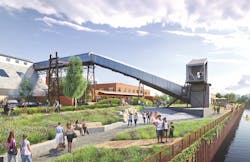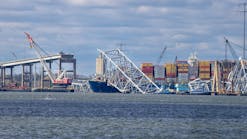Industrial Water & Revitalizing Chicago's Salt District
About the author:
Nicole Davis is director of marketing for Omni Ecosystems. Davis can be reached at [email protected].
by Nicole Davis & Kristen Davis
undefinedWhether you are driving into or out of Chicago on the Kennedy Expressway, it is nearly impossible to miss the large Morton Salt sign atop an industrial facility adjacent to the road.
With the iconic little girl in the yellow rain slicker and the recognizable catchphrase, “When it rains it pours,” Morton Salt has long been a part of the fabric and identity of the city.
In 2015, the salt manufacturer announced plans to close its longtime salt packaging and warehouse facility located at 1357 N. Elston Avenue on Chicago’s Goose Island. As a result, the 4.5-acre parcel became poised for redevelopment.
The site was purchased in 2018 to be revitalized as part of a plan led by Chicago-based developer R2 Companies. The vision for project, coined the Salt District, is to transform it into a mixed-use, entertainment destination and riverfront development. The site will play host to office space, a concert venue and a public Riverwalk while paying homage to its history and creating a nature-driven public space for all to enjoy.
Morton Salt’s recognizable branded rooftop will remain intact through the redevelopment, and its Research and Development Center will be relocated to the site from its current Elgin, Illinois, location when construction is completed.
Chicago-based Omni Ecosystems is leading the landscape design for the Salt District, along with Lamar Johnson Collaborative as architect. The landscape design aims to create an immersive nature experience, providing mutual linking connections between the site and the river while creating accessible, inclusive spaces for gathering and entertainment. Driven by sustainable principles, native species and plantings that restore and replicate nature are featured throughout the design with existing salt hoppers repurposed as tree planters.
Design strategies are intended to bring occupants closer to nature — bench seating is placed at the bottom of the downward-sloping landscape to better connect people to the Riverwalk. A continuous strip of plants along the river and a wood boardwalk through the bioswale gives people additional places to wander.
Overcoming Site Challenges
Having housed a salt production facility for decades and a tannery prior to that, the Morton Salt site faced numerous challenges related to contamination, in addition to having to follow numerous guidelines set by the city of Chicago. This includes meeting a 30-foot Riverwalk requirement to adhere to guidelines for development along the Chicago River and complying with the city’s storm water management ordinance.
Omni Ecosystems worked alongside Chicago’s Department of Buildings to prove the utility of its optimized engineered growing media, Omni Infinity Media, to meet these requirements while also providing a solution to alleviate contamination issues caused by existing conditions.
With high storm water retention and ultra-lightweight qualities, Omni Infinity Media replicates the natural, biological processes of natural soils to create a healthy, self-regenerative soil ecosystem. The media is made up of mostly air, with 78% void space compared to standard topsoil’s void space of 25%. Omni Ecosystems says Omni Infinity Media can infiltrate 51 inches of water per hour, compared to just six inches of water absorbed by standard topsoil, making it unlikely to saturate or overflow because of a storm event.
At the Morton Salt site, Omni Ecosystems worked with the project’s civil engineer, V3 Companies, to determine how much soil could be placed on the site to manage a 100-year storm and where that soil could be best placed and graded.
As a result, Omni Ecosystems will deploy approximately 60,000 cubic feet of its media. The degraded and polluted site has been capped with concrete and asphalt, and Omni Infinity Media will be placed atop this cap to enable an ample wetland and riparian ecosystems to thrive.
On the western half of the site, storm water will drain into the sewer system, and on the eastern half, it will drain into the Chicago River – creating two “watersheds.” Storm water runoff from disturbed areas will be redirected to the media for discharging, and this process enables both detention and volume control amounts to be captured in Omni Infinity Media as surface storage.
The use of this media enables the detention of more than twice the amount of storm water – 2,250 cubic feet – required for the site.
Green Infrastructure Provides Cost Savings
Moreover, the use of Omni Infinity Media at the Salt District has led to substantial cost savings by the developer. The soil mitigates the need for expensive soil remediation or the installation of costly underground storm water management products because the porous, well-drained media is capable of capping off a site while also acting as a “spongey” growing media.
For the Salt District, the use of this media instead of traditional gray infrastructure will save R2 30% of what they would have spent to integrate gray infrastructure, according to an analysis performed by Omni Ecosystems.
In February 2021, the Salt District received approval from the city of Chicago’s Planning Commission, officially marking it as the first project in the city that has received approval to utilize innovative storm water soils to mitigate storm water runoff and combined sewer water flow. This approval is a step in the right direction for Chicago and other cities that face systemic issues related to combined sewer overflow.
Omni Infinity Media has also been approved for storm water management by several other jurisdictions, including Boston, Virginia, Tennessee, Washington D.C. and Maryland.
The redevelopment of Morton Salt will preserve the historic site and reposition it for its next chapter as a notable Chicago landmark that will fill a variety of wants and needs of residents and visitors alike. Approximately 200 construction jobs and 50 permanent jobs are expected to be created from the $30 million project, with $4.5 million in annual tax revenues also anticipated. The use of innovative storm water soil at this site for the first time in Chicago creates a decentralized green infrastructure solution to alleviate combined sewer overflow.






